Telescope Reviews
Page 24
By Ed Ting
Updated 11/20/06
Click on a Telescope Below:
1) Mag 1 Instruments 8" Portaball
2) Edmund Scientific (Scientifics) Astroscan
1) Mag 1 Instruments 8" Portaball 9/30/06, 10/10/06
(8" f/6 Alt Az Newtonian, $2500, many options available)
Hey look - I wrote a review!
During my little sabbatical, it's been gratifying to hear from so many well-wishers out there. I'm
pleased and humbled that so many of you seem to care so much about what I have to say about
telescopes and observing. While I've cut back on some of my astro activities, doing casual
observing and the occasional article for Night Sky magazine, I haven't been sitting still. In the
past year or so I've been playing with some really cool stuff, and I'll write about them from time
to time.
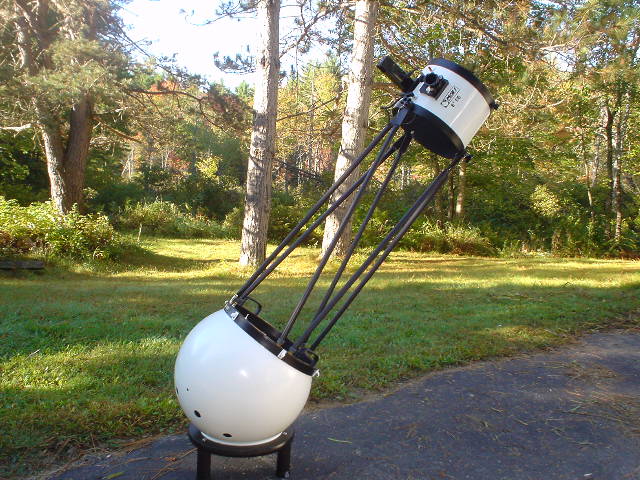 The 8" Portaball
One of those cool telescopes is the 8" Portaball from Mag 1 Instruments. If you haven't seen
one of these before, you're in for a bit of a shock. Portaballs have this Terminator-like
"exoskeleton" design, and they don't look like anything else out there. In reality, a Portaball
is a rather conventional truss Dob mated to a sphere at the bottom that rotates freely. This
"bowling ball" style mount has been used by amateur telescope makers for decades, and was
introduced into astro pop culture by Edmund's Astroscan. The advantages of a rotating sphere
as opposed to a conventional two-axis alt-az system are numerous. First, the eyepiece height
can be varied by a twist of the wrist. Don't like the current eyepiece height? Just give the
upper truss a twirl. In fact, once you get used to having the eyepiece exactly where you want
it, it's hard to go back to a normal alt-az Dob.
But the main advantage of the sphere design is its incredibly smooth motions. On a normal Dob,
the designer spends a lot of time trying to get the "sticktion" of the two axes to be similar.
One quick test I do on any Dob is to pan it from the ground up, at a 45 degree angle. Invariably,
one axis will be tighter than the other, even on the most expensive scopes (this is especially
true as the scope gets near the zenith.) On the Portaball, this isn't an issue. There aren't any
axes. You just move it wherever you want. In fact, the scope's motions are so buttery smooth,
you'll find yourself panning it around just for fun inside the house or the garage during the day.
The 8" Portaball
One of those cool telescopes is the 8" Portaball from Mag 1 Instruments. If you haven't seen
one of these before, you're in for a bit of a shock. Portaballs have this Terminator-like
"exoskeleton" design, and they don't look like anything else out there. In reality, a Portaball
is a rather conventional truss Dob mated to a sphere at the bottom that rotates freely. This
"bowling ball" style mount has been used by amateur telescope makers for decades, and was
introduced into astro pop culture by Edmund's Astroscan. The advantages of a rotating sphere
as opposed to a conventional two-axis alt-az system are numerous. First, the eyepiece height
can be varied by a twist of the wrist. Don't like the current eyepiece height? Just give the
upper truss a twirl. In fact, once you get used to having the eyepiece exactly where you want
it, it's hard to go back to a normal alt-az Dob.
But the main advantage of the sphere design is its incredibly smooth motions. On a normal Dob,
the designer spends a lot of time trying to get the "sticktion" of the two axes to be similar.
One quick test I do on any Dob is to pan it from the ground up, at a 45 degree angle. Invariably,
one axis will be tighter than the other, even on the most expensive scopes (this is especially
true as the scope gets near the zenith.) On the Portaball, this isn't an issue. There aren't any
axes. You just move it wherever you want. In fact, the scope's motions are so buttery smooth,
you'll find yourself panning it around just for fun inside the house or the garage during the day.
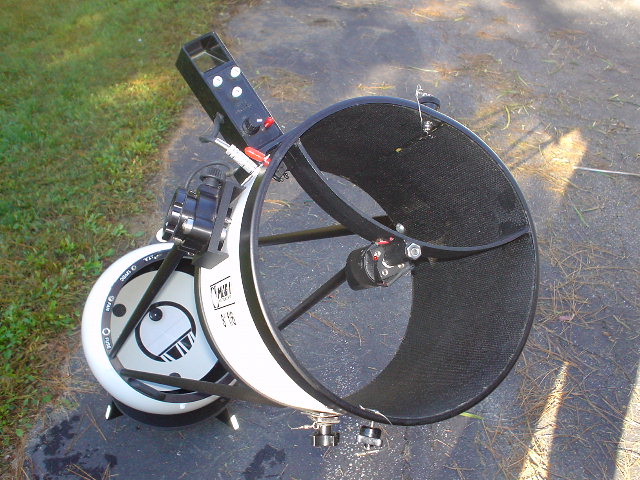 Looking down the upper truss. Note the curved secondary holder.
So why doesn't everyone use this spheroid arrangement? It turns out there are a few drawbacks.
First, in order to do it right, it's expensive. $2500 isn't a lot for a high quality telescope,
but it's a serious chunk of change for many people. Second, there's so little friction that
you're limited as to the amount of weight you can place on the upper truss. Most observers
will have to make do with the super lightweight Rigel Quik Finder, and the focuser is a 1.25"
helical unit (newer Portaballs have a 2" helical Crayford focuser.) Forget about a rack and pinion
focuser. You're limited to lighter eyepieces. I've found that the 19 mm Panoptic balances well
(I'm told the 24 Panoptic balances well too.) No one has yet figured out how to mount digital
setting circles to a scope like this. So if you're the type that like to have lots of electronic
toys on their scope, the Portaball may not be for you. If you want the scope to track, you'll
need to use an equatorial table (Mag 1 sells them.) Finally, some people think the scope looks
funny (I think it looks really cool, but I'm a geek.)
Looking down the upper truss. Note the curved secondary holder.
So why doesn't everyone use this spheroid arrangement? It turns out there are a few drawbacks.
First, in order to do it right, it's expensive. $2500 isn't a lot for a high quality telescope,
but it's a serious chunk of change for many people. Second, there's so little friction that
you're limited as to the amount of weight you can place on the upper truss. Most observers
will have to make do with the super lightweight Rigel Quik Finder, and the focuser is a 1.25"
helical unit (newer Portaballs have a 2" helical Crayford focuser.) Forget about a rack and pinion
focuser. You're limited to lighter eyepieces. I've found that the 19 mm Panoptic balances well
(I'm told the 24 Panoptic balances well too.) No one has yet figured out how to mount digital
setting circles to a scope like this. So if you're the type that like to have lots of electronic
toys on their scope, the Portaball may not be for you. If you want the scope to track, you'll
need to use an equatorial table (Mag 1 sells them.) Finally, some people think the scope looks
funny (I think it looks really cool, but I'm a geek.)
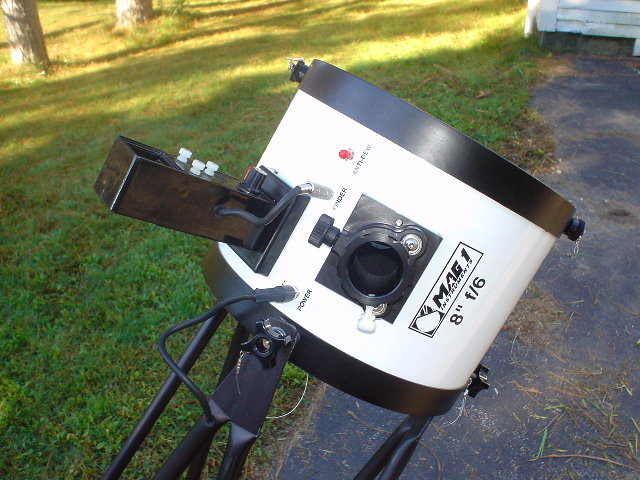 Close up on the upper truss assembly. This one has the electrical package.
This sample one is a slightly older version that operates at f/6. Newer versions are f/5.5. The
owner bought it used and had the whole thing sent to me. Everything collapses down into a small
package. Mag 1 wants you to send back tub for a small refund, but if you can, figure out a way
to keep it. It provides a safe, protective environment for your Portaball when you're not using
it, and it doubles as a shipping carton. If you're traveling to a distant star party and want to
have a scope with you, you can always send the Portaball out in advance. The shipping charges
shouldn't be too bad, as the entire scope weighs only 32 lbs. For comparision, an Orion XT6
weighs in at 34.4 lbs and can't realistically be broken down at all for shipping.
Set aside some time when you first get the scope. Even if you've put together many scopes before,
it will take you some time to get familiar with how the Portaball goes together. Pay particular
attention to how the mirror sits inside the sphere. It's dark down there, and there are a lot
of clips, springs, and other mechanisms that you have to get just right. If you ordered the
electrical package, be sure not to tug too hard on the wires while assembling the scope. Once
everything is together, note that the mirror gets collimated using three screws in the front of
the sphere.
There are lots of options. You can get a sphere electrical package that powers a fan. There's also
an upper truss electrical package that powers your Rigel Quik Finder and anti-dew equipment. You
can buy a transport cart, and there's now an option for a 6X30 right angle finder. All this stuff
is cool, but keep track of your tab - a fully tricked out Portaball can run into some serious money.
Close up on the upper truss assembly. This one has the electrical package.
This sample one is a slightly older version that operates at f/6. Newer versions are f/5.5. The
owner bought it used and had the whole thing sent to me. Everything collapses down into a small
package. Mag 1 wants you to send back tub for a small refund, but if you can, figure out a way
to keep it. It provides a safe, protective environment for your Portaball when you're not using
it, and it doubles as a shipping carton. If you're traveling to a distant star party and want to
have a scope with you, you can always send the Portaball out in advance. The shipping charges
shouldn't be too bad, as the entire scope weighs only 32 lbs. For comparision, an Orion XT6
weighs in at 34.4 lbs and can't realistically be broken down at all for shipping.
Set aside some time when you first get the scope. Even if you've put together many scopes before,
it will take you some time to get familiar with how the Portaball goes together. Pay particular
attention to how the mirror sits inside the sphere. It's dark down there, and there are a lot
of clips, springs, and other mechanisms that you have to get just right. If you ordered the
electrical package, be sure not to tug too hard on the wires while assembling the scope. Once
everything is together, note that the mirror gets collimated using three screws in the front of
the sphere.
There are lots of options. You can get a sphere electrical package that powers a fan. There's also
an upper truss electrical package that powers your Rigel Quik Finder and anti-dew equipment. You
can buy a transport cart, and there's now an option for a 6X30 right angle finder. All this stuff
is cool, but keep track of your tab - a fully tricked out Portaball can run into some serious money.
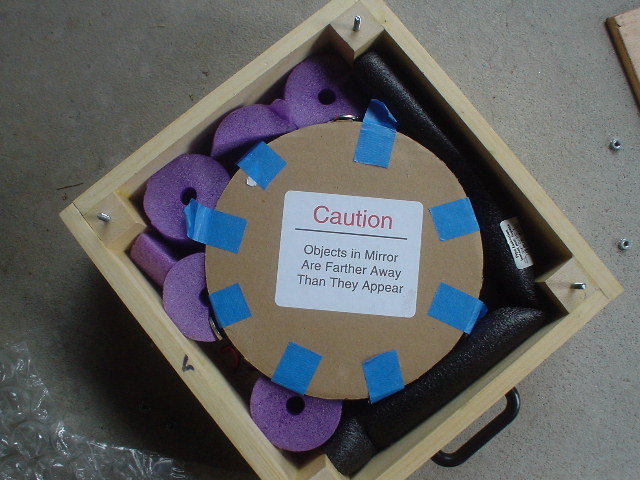 Now here's what I like - a designer with a sense of humor
I've seen plenty of these in observing fields before, but this was my first chance to spend quality time
with one. I had it out in my driveway with the 20" Obsession, an Orion 120 mm f/5 refractor, a Celestron
C102, and other scopes. Not exactly comparable scopes, but there's enough variety to judge where the
Portaball sits in the grand scheme of things.
We looked at a number of fall objects, starting with the obvious stuff - M11, the Ring, Dumbbell, Veil,
M31, M13, and other showpieces. What became clear almost immediately is how sharp and contrasty
the mirror is. The Zambuto mirror was superb as usual. You could have been fooled into thinking
you're looking into a high quality 6"-8" refractor. The secondary is mounted on a cool curved spider,
so there aren't any diffraction spikes. This adds to the illusion that you're looking through an
unobstructed optical system. Looking at the Veil with a 19 mm Panoptic and an Ultrablock filter,
for instance, the views were rich and detailed, and it wasn't as far behind the big 20" Obsession
as you might think. The Big Guy threw up bigger and brighter views of course, but the Portaball
kept up surprisingly well. In fact, even without the Ultrablock filter, and without the shroud in place,
it was still possible to make out parts of the Veil with the 19 mm Panoptic and the 13 mm Nagler.
With the same 19 mm Panoptic/Ultrablock combo, the Dumbbell looked more like a football than a Dumbbell.
Then we started going after more obscure stuff. We found NGC 6946/6939, and NGC 40 in Cepheus. The
distant NGC 6934 in Delphinus was no problem. The Blue Snowball and Blinking Planetary both showed
bluish-greenish color. In Hercules, NGC 6210 was no problem. NGC 6207 and M13 were easily framed in
the same field of view.
Now here's what I like - a designer with a sense of humor
I've seen plenty of these in observing fields before, but this was my first chance to spend quality time
with one. I had it out in my driveway with the 20" Obsession, an Orion 120 mm f/5 refractor, a Celestron
C102, and other scopes. Not exactly comparable scopes, but there's enough variety to judge where the
Portaball sits in the grand scheme of things.
We looked at a number of fall objects, starting with the obvious stuff - M11, the Ring, Dumbbell, Veil,
M31, M13, and other showpieces. What became clear almost immediately is how sharp and contrasty
the mirror is. The Zambuto mirror was superb as usual. You could have been fooled into thinking
you're looking into a high quality 6"-8" refractor. The secondary is mounted on a cool curved spider,
so there aren't any diffraction spikes. This adds to the illusion that you're looking through an
unobstructed optical system. Looking at the Veil with a 19 mm Panoptic and an Ultrablock filter,
for instance, the views were rich and detailed, and it wasn't as far behind the big 20" Obsession
as you might think. The Big Guy threw up bigger and brighter views of course, but the Portaball
kept up surprisingly well. In fact, even without the Ultrablock filter, and without the shroud in place,
it was still possible to make out parts of the Veil with the 19 mm Panoptic and the 13 mm Nagler.
With the same 19 mm Panoptic/Ultrablock combo, the Dumbbell looked more like a football than a Dumbbell.
Then we started going after more obscure stuff. We found NGC 6946/6939, and NGC 40 in Cepheus. The
distant NGC 6934 in Delphinus was no problem. The Blue Snowball and Blinking Planetary both showed
bluish-greenish color. In Hercules, NGC 6210 was no problem. NGC 6207 and M13 were easily framed in
the same field of view.
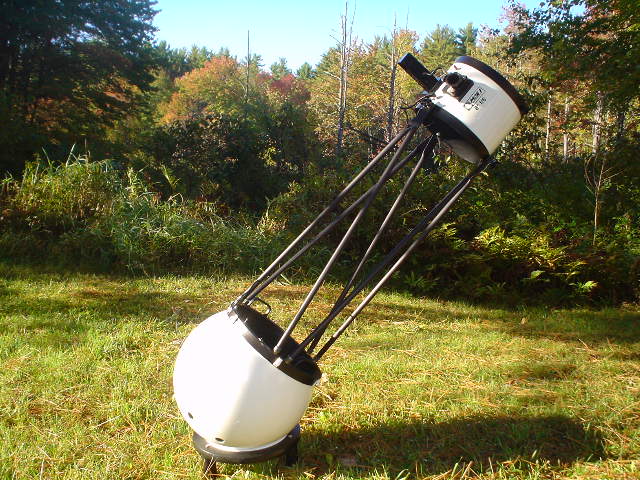 If you need to move the scope in the field (say, to get a view around a tree or building) you're going
to have an issue with transport. You don't want to just set the sphere on the ground for fear of
scratching it. One option is to have a friend pick up the scope while you move the base (there are
handles on the sphere) but if you're alone and don't have the transport cart you're going to have to
be careful. A good solution is to order a separate base from Mag 1 and "hopscotch" the scope across
the observing field as your needs arise. I understand that some people have built their own bases
out of composite/wood, and teflon. If you make one yourself, be careful that your creation does not
scratch the sphere.
There are other models in the series as well. While the 8" seems to be the most popular, there are
also 10", 12.5" and 14" models available. Delivery on them varies from 4 months to nearly a year.
There have also been rumors out there of a 6" f/5 Mini-Portaball, which is a tempting prospect.
Portaballs have always been a kind of cult-scope, but they're entering the mainstream. Pete Smikta's
booth is usually quite popular at trade shows and star parties. If you get one, there will be plenty
of owners out there willing to help you.
The 8" Portaball delivers great images, it's got buttery smooth motions, collapses into an easily
transportable package, and is just plain fun to use. What more could you want?
If you like this scope, you may also like:
Starmaster V8 ($2895) - A fancy, high tech take on the classic 8" Dobsonian.
If you want to spend less money, try:
Orion Skyquest XT8 ($359) - Not as refined as the high end scopes, but you get a Real Telescope for
almost no money. Still the budget king after all these years.
Discovery 8" PDHQ Dob ($999) - A traditional 8" Dobsonian with nice fit and finish.
If you need to move the scope in the field (say, to get a view around a tree or building) you're going
to have an issue with transport. You don't want to just set the sphere on the ground for fear of
scratching it. One option is to have a friend pick up the scope while you move the base (there are
handles on the sphere) but if you're alone and don't have the transport cart you're going to have to
be careful. A good solution is to order a separate base from Mag 1 and "hopscotch" the scope across
the observing field as your needs arise. I understand that some people have built their own bases
out of composite/wood, and teflon. If you make one yourself, be careful that your creation does not
scratch the sphere.
There are other models in the series as well. While the 8" seems to be the most popular, there are
also 10", 12.5" and 14" models available. Delivery on them varies from 4 months to nearly a year.
There have also been rumors out there of a 6" f/5 Mini-Portaball, which is a tempting prospect.
Portaballs have always been a kind of cult-scope, but they're entering the mainstream. Pete Smikta's
booth is usually quite popular at trade shows and star parties. If you get one, there will be plenty
of owners out there willing to help you.
The 8" Portaball delivers great images, it's got buttery smooth motions, collapses into an easily
transportable package, and is just plain fun to use. What more could you want?
If you like this scope, you may also like:
Starmaster V8 ($2895) - A fancy, high tech take on the classic 8" Dobsonian.
If you want to spend less money, try:
Orion Skyquest XT8 ($359) - Not as refined as the high end scopes, but you get a Real Telescope for
almost no money. Still the budget king after all these years.
Discovery 8" PDHQ Dob ($999) - A traditional 8" Dobsonian with nice fit and finish.
Update, 10/10/06: Pete Smitka sent me some updates and comments. The unit reviewed above is about
5 years old and since that time improvements have been made. In his words:
"Included is a picture of the new stand which would be similar to the one here. The most important
change is in the bearing, which is a material called PFA. It's a Teflon cousin, but similar in color to
polypropylene (think milk bottles), and four times as hard as Teflon. That translates into a better
balance between dynamic and static friction (no "stiction") due to the cold forming Teflon has, and
with its larger contact area a somewhat higher static friction allowing a greater range of imbalance.
You can see the engineering effects of this material in an article written by Martin Lewis in the Oct
2003 edition of Sky & Telescope.
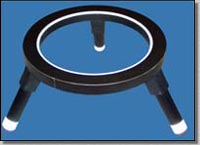 The new Portaball base
"The other major changes are the changes in the mirror cell, and power capacity. The mirror cells in
all my scopes are now fully CNC machined and anodized aluminum. They utilize a six point support
using spherical bearings as pivots, similar to what's pictured here.
The new Portaball base
"The other major changes are the changes in the mirror cell, and power capacity. The mirror cells in
all my scopes are now fully CNC machined and anodized aluminum. They utilize a six point support
using spherical bearings as pivots, similar to what's pictured here.
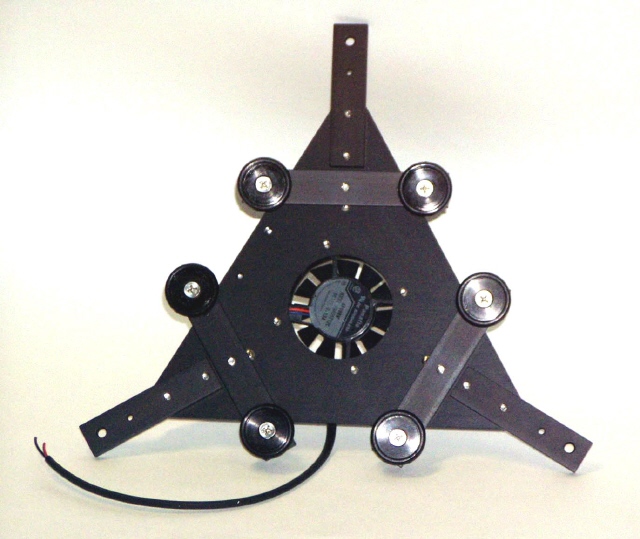 The new mirror cell
"The internal battery capacity has been increased 50% to 1.2 aH, and are separated from the cell, making
cell installation easier.
"Other changes are more subtle but add to the user's experience: the shroud and light shield are now
standard equipment and the shield installation simplified; the collimation and UTA attachment knobs
have been changed to a more hand and glove friendly round, knurled shape; the internal wiring has
been improved; the truss pole upper ends are now a casting rather than being crushed which translates
into more consistent collimation, plus as you noted in your article the elimination of the two f/ratios,
replacing them with a single f/5.5 which has a 2" Helical-Crayford focuser allowing for moderate weight
2" eyepieces (still no Nagrenades, this scope is a sports car not a truck!) I am committed to this
design, as even with its current electronic limitations, it has much to recommend it: 4X the light
gathering capability and double the resolution of a 100 mm apo refractor at a equivalent level of
optical quality, for less than such a tube assembly alone, and weighing less and as easy to set up
(and when disassembled taking up less space) ... well the list goes on. So pardon my ramblings,
but I needed to point out how different the instrument you had is from those purchased now. I expect
there will be changes in the future as well, since I'm constantly trying to find new materials,
methods, and refinements in response to feedback from users. Thanks for your indulgence."
2) Edmund Scientific (Scientifics) Astroscan 11/20/06
(4 1/8" f/4.2 Alt-Az Newtonian, 28 mm, 15 mm RKE eyepieces, base, $199 direct)
Although I've been recommending this scope to beginners for years, this is the first one I've actually owned.
My experience has been limited to quick peeks at star parties. My impression of Edmund's little red scope
has been consistent, however. It's a beginner's telscope, a decent quick peek/second scope, and a piece of
scientific nostalgia.
Don't underestimate that last point. I remember looking through those little digest-sized Edmund Scientific
catalogs as a kid and dreaming about owning an Astroscan someday. The ads were wonderful. One photo
showed a kid cradling one like a pet as he looked through it. Another showed a man rock climbing(!)
with an Astroscan strapped to his back. The Astroscan has been in continuous production for thirty
years with virtually no changes. How many other models can even come close to making that claim?
(by the way, if anyone out there has one of those old digest-sized Edmund catalogs, please contact me!)
The new mirror cell
"The internal battery capacity has been increased 50% to 1.2 aH, and are separated from the cell, making
cell installation easier.
"Other changes are more subtle but add to the user's experience: the shroud and light shield are now
standard equipment and the shield installation simplified; the collimation and UTA attachment knobs
have been changed to a more hand and glove friendly round, knurled shape; the internal wiring has
been improved; the truss pole upper ends are now a casting rather than being crushed which translates
into more consistent collimation, plus as you noted in your article the elimination of the two f/ratios,
replacing them with a single f/5.5 which has a 2" Helical-Crayford focuser allowing for moderate weight
2" eyepieces (still no Nagrenades, this scope is a sports car not a truck!) I am committed to this
design, as even with its current electronic limitations, it has much to recommend it: 4X the light
gathering capability and double the resolution of a 100 mm apo refractor at a equivalent level of
optical quality, for less than such a tube assembly alone, and weighing less and as easy to set up
(and when disassembled taking up less space) ... well the list goes on. So pardon my ramblings,
but I needed to point out how different the instrument you had is from those purchased now. I expect
there will be changes in the future as well, since I'm constantly trying to find new materials,
methods, and refinements in response to feedback from users. Thanks for your indulgence."
2) Edmund Scientific (Scientifics) Astroscan 11/20/06
(4 1/8" f/4.2 Alt-Az Newtonian, 28 mm, 15 mm RKE eyepieces, base, $199 direct)
Although I've been recommending this scope to beginners for years, this is the first one I've actually owned.
My experience has been limited to quick peeks at star parties. My impression of Edmund's little red scope
has been consistent, however. It's a beginner's telscope, a decent quick peek/second scope, and a piece of
scientific nostalgia.
Don't underestimate that last point. I remember looking through those little digest-sized Edmund Scientific
catalogs as a kid and dreaming about owning an Astroscan someday. The ads were wonderful. One photo
showed a kid cradling one like a pet as he looked through it. Another showed a man rock climbing(!)
with an Astroscan strapped to his back. The Astroscan has been in continuous production for thirty
years with virtually no changes. How many other models can even come close to making that claim?
(by the way, if anyone out there has one of those old digest-sized Edmund catalogs, please contact me!)
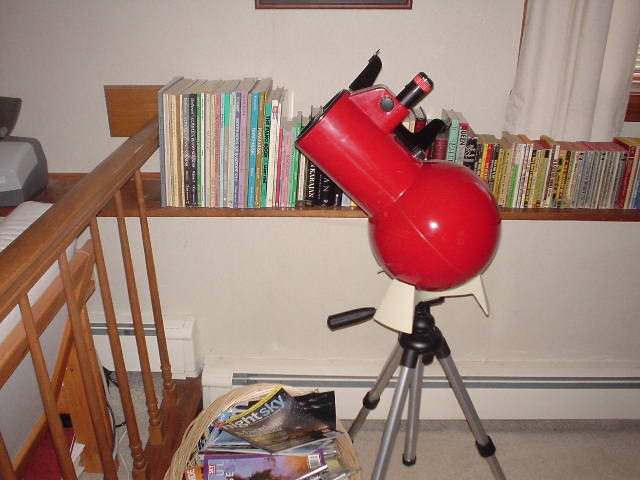 A classic - Edmund's Astroscan
The scope is about as simple as it gets. There's a 4 1/8" parabolic mirror permanently mounted at
the bottom of a spherical ball. The secondary is mounted on the back side of a clear plastic cover
at the front of the scope. The coatings on this cover are so-so, with some reflections visible in
the daytime. The focuser is a friction style unit. These focusers vary a lot in their feel. Mine
is pretty tight, and on cold nights I sometimes have to "help" the focuser a bit by pulling on the
drawtube with my hands while turning the knob. The scope weighs about 10.75 lbs, which is heavier
than it looks. The extra weight comes from a circular metal plate mounted to the rear of the ball.
A metal peepsight is mounted to the upper part of the scope. The alignment of this peepsight seems
to wander a bit since it's free to rotate around its mounting screw, but with a 3 degree field of view, it
doesn't matter much in practice. The 28 mm RKE eyepiece is of good quality and fits well with the
scope. However, with the scope operating at an ultra fast f/4.2, the exit pupil is flirting with 6.7 mm,
which some observers find uncomfortable. If you stay with the RKEs, try the 21 mm instead. The
scope comes with an impressive collection of books and charts to help you get started in astronomy.
You're going to have to figure out how to get the scope up off the ground. This is likely to be your biggest
issue as a new Astroscan owner, so I'll spend some time talking about this. First of all, setting the
scope on the ground may be fine for very young kids, but unless you can get it raised up above waist level,
you're going to have a sore neck and back from stooping over so much (this is true of many kids scopes,
like the Orion Starblast or the XT 4.5.) The entire scope sits on a 3 point felt-lined metal mount. The
manual states that all you need to do is set it on a "sturdy, flat surface" to start observing, but it's not
quite that easy.
A classic - Edmund's Astroscan
The scope is about as simple as it gets. There's a 4 1/8" parabolic mirror permanently mounted at
the bottom of a spherical ball. The secondary is mounted on the back side of a clear plastic cover
at the front of the scope. The coatings on this cover are so-so, with some reflections visible in
the daytime. The focuser is a friction style unit. These focusers vary a lot in their feel. Mine
is pretty tight, and on cold nights I sometimes have to "help" the focuser a bit by pulling on the
drawtube with my hands while turning the knob. The scope weighs about 10.75 lbs, which is heavier
than it looks. The extra weight comes from a circular metal plate mounted to the rear of the ball.
A metal peepsight is mounted to the upper part of the scope. The alignment of this peepsight seems
to wander a bit since it's free to rotate around its mounting screw, but with a 3 degree field of view, it
doesn't matter much in practice. The 28 mm RKE eyepiece is of good quality and fits well with the
scope. However, with the scope operating at an ultra fast f/4.2, the exit pupil is flirting with 6.7 mm,
which some observers find uncomfortable. If you stay with the RKEs, try the 21 mm instead. The
scope comes with an impressive collection of books and charts to help you get started in astronomy.
You're going to have to figure out how to get the scope up off the ground. This is likely to be your biggest
issue as a new Astroscan owner, so I'll spend some time talking about this. First of all, setting the
scope on the ground may be fine for very young kids, but unless you can get it raised up above waist level,
you're going to have a sore neck and back from stooping over so much (this is true of many kids scopes,
like the Orion Starblast or the XT 4.5.) The entire scope sits on a 3 point felt-lined metal mount. The
manual states that all you need to do is set it on a "sturdy, flat surface" to start observing, but it's not
quite that easy.
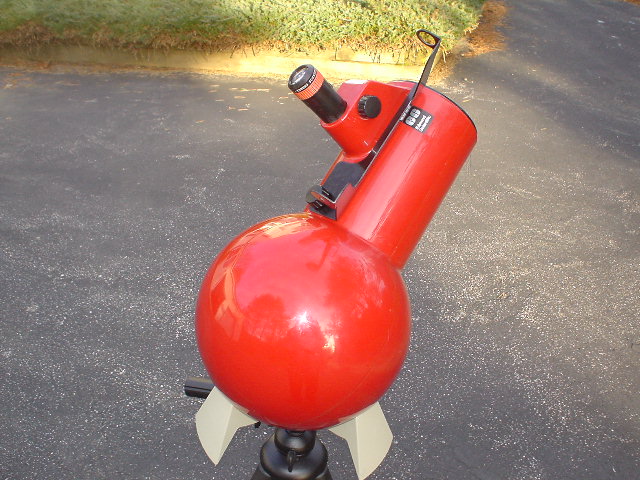 A little shaky, but it works - the Astroscan on a Bogen Jr (model 3405)
First of all, the surface needs to be very steady. Cradling it in your arms like the kid in the ad
won't work. Even a picnic table can be shaky. You can screw a tripod into the 1/4" X 20 hole in the base,
but you might run into problems there, too. The hole is recessed in the base, and most tripod bolts aren't
long enough to reach. I managed to rig a Bogen plate by removing the Bogen 1/4" X 20 screw and threading
in a 3/4" 1/4" X 20 set screw. Even then, I had to be careful to shim the screw with washers. If the screw
is too long, it reaches in and scratches the Astroscan, or interferes with the clamping mechanism of the
tripod. Too short and it won't reach. Also, you'd better have a good tripod. My Bogen 3001 is adequate,
and my 3405 "Junior" is perhaps a little less so (the scope feels very top heavy and I'm afraid of bumping
it in the dark.) If you can pick up one of those astro-modified surveyor tripods, that's a good start.
However, a good tripod can cost as much as the scope itself so figure that into your budget. If you don't
want to deal with the mounting screw issues, Scientifics does sell a dedicated tripod bracket for $49.95
(you still have to supply the tripod.)
A little shaky, but it works - the Astroscan on a Bogen Jr (model 3405)
First of all, the surface needs to be very steady. Cradling it in your arms like the kid in the ad
won't work. Even a picnic table can be shaky. You can screw a tripod into the 1/4" X 20 hole in the base,
but you might run into problems there, too. The hole is recessed in the base, and most tripod bolts aren't
long enough to reach. I managed to rig a Bogen plate by removing the Bogen 1/4" X 20 screw and threading
in a 3/4" 1/4" X 20 set screw. Even then, I had to be careful to shim the screw with washers. If the screw
is too long, it reaches in and scratches the Astroscan, or interferes with the clamping mechanism of the
tripod. Too short and it won't reach. Also, you'd better have a good tripod. My Bogen 3001 is adequate,
and my 3405 "Junior" is perhaps a little less so (the scope feels very top heavy and I'm afraid of bumping
it in the dark.) If you can pick up one of those astro-modified surveyor tripods, that's a good start.
However, a good tripod can cost as much as the scope itself so figure that into your budget. If you don't
want to deal with the mounting screw issues, Scientifics does sell a dedicated tripod bracket for $49.95
(you still have to supply the tripod.)
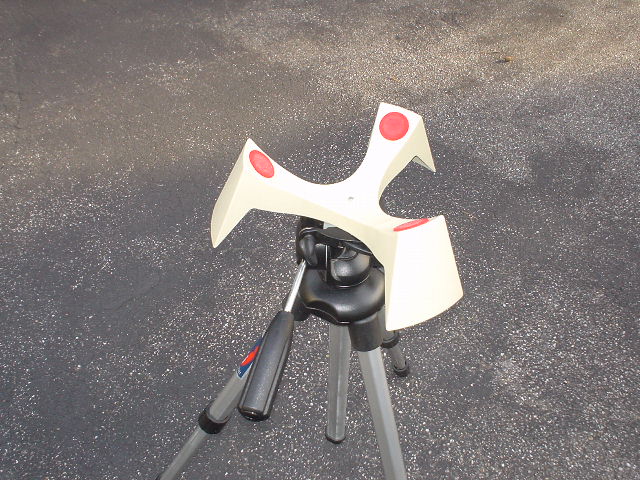 The base mated to the Bogen Jr. Note threaded 1/4" X 20 screw poking out of bottom of base
Edmund always advertised these as Serious Telescopes, but among enthusiasts today, the Astroscan
is thought of as a bit of a toy. I must admit to some snobbery myself in this department. But when I
set it up, I was pleasantly surprised. At a recent skywatch, children and adults alike flocked to my
Astroscan setup, largely ignoring my 6" Dob. More than once, I was told my telescope was "cool."
The 28 mm RKE yields a huge field of view at 16X and you can frame the Double Cluster, Pleiades,
or M31 very nicely. If you're new at this, the 3 degree FOV gives you a large margin of error as
you learn the night sky.
As you push the magnification, however, things get a little worse. Mine is slightly out of collimation,
and with a 13 mm eyepiece (34X) images start to get a little blurry. Go over 50X and there is some
jerkiness to the scope's motions (my Bogens start to give out around these powers as well.) So consider
this a quick peek wide field telescope. Still, 30X is just enough to make out the rings of Saturn and
cloud belts on Jupiter so it could be a good introduction to planetary observing for a newcomer. Also
note that on humid nights, the secondary cover dews over pretty quickly. The friction between the ball
and the base is a little stiff. If you pan large acrs it's smooth, but if you need to fine tune the scope's
position, it gets a little sticky. I tried waxing the sphere with a number of car waxes and Armor All,
but this sticktion remained. I guess it's just something you'll have to accept.
The base mated to the Bogen Jr. Note threaded 1/4" X 20 screw poking out of bottom of base
Edmund always advertised these as Serious Telescopes, but among enthusiasts today, the Astroscan
is thought of as a bit of a toy. I must admit to some snobbery myself in this department. But when I
set it up, I was pleasantly surprised. At a recent skywatch, children and adults alike flocked to my
Astroscan setup, largely ignoring my 6" Dob. More than once, I was told my telescope was "cool."
The 28 mm RKE yields a huge field of view at 16X and you can frame the Double Cluster, Pleiades,
or M31 very nicely. If you're new at this, the 3 degree FOV gives you a large margin of error as
you learn the night sky.
As you push the magnification, however, things get a little worse. Mine is slightly out of collimation,
and with a 13 mm eyepiece (34X) images start to get a little blurry. Go over 50X and there is some
jerkiness to the scope's motions (my Bogens start to give out around these powers as well.) So consider
this a quick peek wide field telescope. Still, 30X is just enough to make out the rings of Saturn and
cloud belts on Jupiter so it could be a good introduction to planetary observing for a newcomer. Also
note that on humid nights, the secondary cover dews over pretty quickly. The friction between the ball
and the base is a little stiff. If you pan large acrs it's smooth, but if you need to fine tune the scope's
position, it gets a little sticky. I tried waxing the sphere with a number of car waxes and Armor All,
but this sticktion remained. I guess it's just something you'll have to accept.
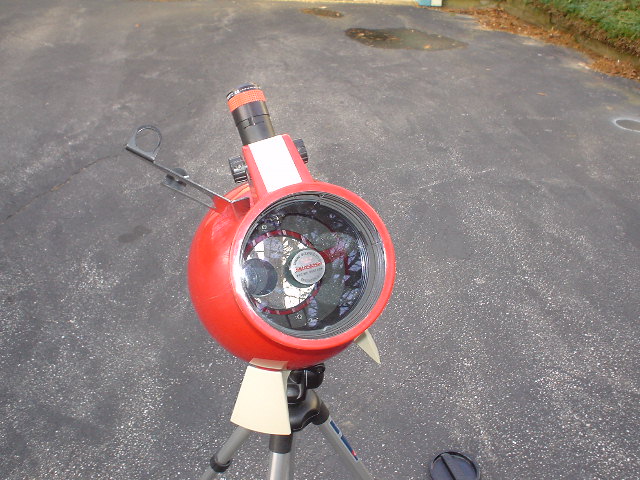 Looking down into the scope. Note metal ring around primary mirror.
It's often said that portable scopes will show you more than big ones because you use them more. It's
true. One night I was waiting in my driveway for my ride to our local astronomy club meeting. Knowing
the guys could show up at any moment, it didn't make sense to haul out the 20" Obsession, or even the 6"
Dob. I grabbed the Astroscan and starting looking around. I looked at M33, NGC457, M56, Albireo, M15,
and the Double Cluster. I screwed an OIII filter into a 19 mm Panoptic and saw both parts of the Veil
Nebula. Yes, the view was dim, but any time you see the complate Veil in a small cheap scope, it's a
victory. The point is, the Astroscan gave me a half hour's worth of observing I wouldn't have gotten
otherwise. And that's worth something.
Astroscans hold their value quite well on the used market. If you buy one used, it's a plus if the unit
comes with the peepsight, 28 mm and 15 mm RKEs, and the shoulder strap (these parts can be hard
to find by themselves.) The Scientifics web site lists numerous accessories.
It's no planetary scope, but this whole package turned out to be better than I expected. I'm keeping it.
Recommended.
Scientifics Astroscan Hots:
Looking down into the scope. Note metal ring around primary mirror.
It's often said that portable scopes will show you more than big ones because you use them more. It's
true. One night I was waiting in my driveway for my ride to our local astronomy club meeting. Knowing
the guys could show up at any moment, it didn't make sense to haul out the 20" Obsession, or even the 6"
Dob. I grabbed the Astroscan and starting looking around. I looked at M33, NGC457, M56, Albireo, M15,
and the Double Cluster. I screwed an OIII filter into a 19 mm Panoptic and saw both parts of the Veil
Nebula. Yes, the view was dim, but any time you see the complate Veil in a small cheap scope, it's a
victory. The point is, the Astroscan gave me a half hour's worth of observing I wouldn't have gotten
otherwise. And that's worth something.
Astroscans hold their value quite well on the used market. If you buy one used, it's a plus if the unit
comes with the peepsight, 28 mm and 15 mm RKEs, and the shoulder strap (these parts can be hard
to find by themselves.) The Scientifics web site lists numerous accessories.
It's no planetary scope, but this whole package turned out to be better than I expected. I'm keeping it.
Recommended.
Scientifics Astroscan Hots:
Low price
Good at low powers
Ships with an impressive collection of books and charts
Distinctive appearance
Scientifics Astroscan Nots:
Needs to be lifted off the ground
Not so great at mid to high powers
Tight focuser on my sample
Distinctive appearance
The Verdict: A good, cheap beginner's scope, and a piece of astro history
If you like the Astroscan, you may also like:
Orion Starblast ($179) - A modern take on the Astroscan concept
Orion Skyquest XT 4.5 ($229) - A step up from the A'Scan, and an excellent first Big Scope for a child
End Telescope Reviews, Page 24
Back to Home Page
 The new Portaball base
The new Portaball base The new mirror cell
The new mirror cell